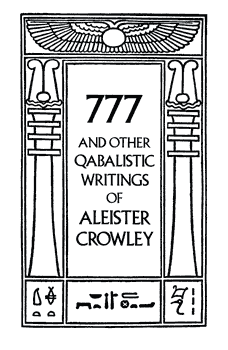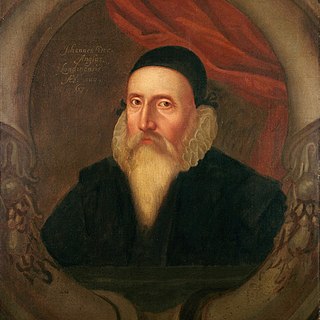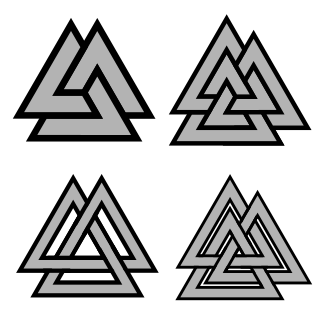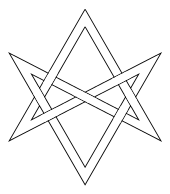
A heptagram, septagram, septegram or septogram is a seven-point star drawn with seven straight strokes.

A pentagram is a regular five-pointed star polygon, formed from the diagonal line segments of a convex regular pentagon. Drawing a circle around the five points creates a similar symbol referred to as the pentacle, which is used widely by Wiccans and in paganism, or as a sign of life and connections. The word "pentagram" refers only to the five-pointed star, not the surrounding circle of a pentacle.

777 and Other Qabalistic Writings of Aleister Crowley is a collection of papers written by Aleister Crowley. It is a table of magical correspondences. It was edited and introduced by Dr. Israel Regardie, and is a reference book based on the Hermetic Qabalah.

Ceremonial magic encompasses a wide variety of rituals of magic. The works included are characterized by ceremony and numerous requisite accessories to aid the practitioner. It can be seen as an extension of ritual magic, and in most cases synonymous with it. Popularized by the Hermetic Order of the Golden Dawn, it draws on such schools of philosophical and occult thought as Hermetic Qabalah, Enochian magic, Thelema, and the magic of various grimoires. Ceremonial magic is part of Hermeticism and Western esotericism.
A pentacle is a talisman that is used in magical evocation, and is usually made of parchment, paper, cloth, or metal, upon which a magical design is drawn. Symbols may also be included, a common one being the six-point form of the Seal of Solomon.

Enochian magic is a system of Renaissance magic developed by John Dee and Edward Kelley. The origins of this esoteric tradition are rooted in documented collaborations between Dee and Kelley, encompassing the revelation of the Enochian language and script, which Dee wrote were delivered to them directly by various angels during their mystical interactions.

A hexagram (Greek) or sexagram (Latin) is a six-pointed geometric star figure with the Schläfli symbol {6/2}, 2{3}, or {{3}}. Since there are no true regular continuous hexagrams, the term is instead used to refer to a compound figure of two equilateral triangles. The intersection is a regular hexagon.

The Rose Cross is a symbol largely associated with the legendary Christian Rosenkreuz; Christian Kabbalist, alchemist, and founder of the Rosicrucian Order. The Rose Cross is a cross with a rose at its centre, often red, golden or white and symbolizes the teachings of a Western esoteric tradition with Christian tenets.

The Seal of Solomon or Ring of Solomon is the legendary signet ring attributed to the Israelite king Solomon in medieval mystical traditions, from which it developed in parallel within Jewish mysticism, Islamic mysticism and Western occultism.

The valknut is a symbol consisting of three interlocked triangles. It appears on a variety of objects from the archaeological record of the ancient Germanic peoples. The term valknut is a modern development; it is not known what term or terms were used to refer to the symbol historically.
Abrahadabra is a word that first publicly appeared in The Book of the Law (1904), the central sacred text of Thelema. Its author, Aleister Crowley, described it as "the Word of the Aeon, which signifieth The Great Work accomplished." This is in reference to his belief that the writing of Liber Legis heralded a new Aeon for mankind that was ruled by the god Ra-Hoor-Khuit. Abrahadabra is, therefore, the "magical formula" of this new age. It is not to be confused with the Word of the Law of the Aeon, which is Thelema, meaning "Will".

Tiferet alternatively Tifaret, Tiphareth, Tifereth or Tiphereth, is the sixth sefira in the kabbalistic Tree of Life. It has the common association of "Spirituality", "Balance", "Integration", "Beauty", "Miracles", and "Compassion".
The tree of life is a diagram used in Rabbinical Judaism in kabbalah and other mystical traditions derived from it. It is usually referred to as the "kabbalistic tree of life" to distinguish it from the tree of life that appears alongside the tree of the knowledge of good and evil in the Genesis creation narrative and well as the archetypal tree of life found in many cultures.
Within the system of Thelema, the Night of Pan, or N.O.X., is a mystical state that represents the stage of ego-death in the process of spiritual attainment.
Within Thelema, the Great Work is the spiritual endeavor aimed at realizing one's True Will and achieving a profound mystical union with the All. This path, crafted by Aleister Crowley, draws inspiration from Hermetic alchemy and the Hermetic Qabalah. The cornerstone of Thelema is the Book of the Law, received by Crowley in 1904 through a communication with the entity Aiwass. This text became the central scripture, heralding a new Aeon for humanity and outlining the principles of Thelema.

In ceremonial magic, a magical formula or a word of power is a word that is believed to have specific supernatural effects. They are words whose meaning illustrates principles and degrees of understanding that are often difficult to relay using other forms of speech or writing. It is a concise means to communicate very abstract information through the medium of a word or phrase.
In ceremonial magic, banishing refers to one or more rituals intended to remove non-physical influences ranging from spirits to negative influences. Although banishing rituals are often used as components of more complex ceremonies, they can also be performed by themselves. Banishing can be viewed as one of several techniques of magic, closely related to ritual purification and a typical prerequisite for consecration and invocation.

The Lesser Ritual of the Pentagram is a ceremonial magic ritual devised and used by the original order of the Golden Dawn that has become a mainstay in modern occultism. This ritual is considered by many to be a basic preliminary to any other magical work, so much that it was the only ritual, besides initiation rituals, taught to members of the Golden Dawn before they advanced to the Inner Order.
English Qaballa (EQ) is a system of Hermetic Qabalah, supported by a system of arithmancy that interprets the letters of the English alphabet via an assigned set of values, discovered by James Lees in 1976. It is the result of an intent to understand, interpret, and elaborate on the mysteries of Aleister Crowley's received text, Liber AL vel Legis, the Book of the Law. According to Jake Stratton-Kent, "the English Qaballa is a qabalah and not a system of numerology. A qabalah is specifically related to three factors: one, a language; two, a 'holy' text or texts; three, mathematical laws at work in these two."

In mathematical knot theory, 74 is the name of a 7-crossing knot which can be visually depicted in a highly-symmetric form, and so appears in the symbolism and/or artistic ornamentation of various cultures.















